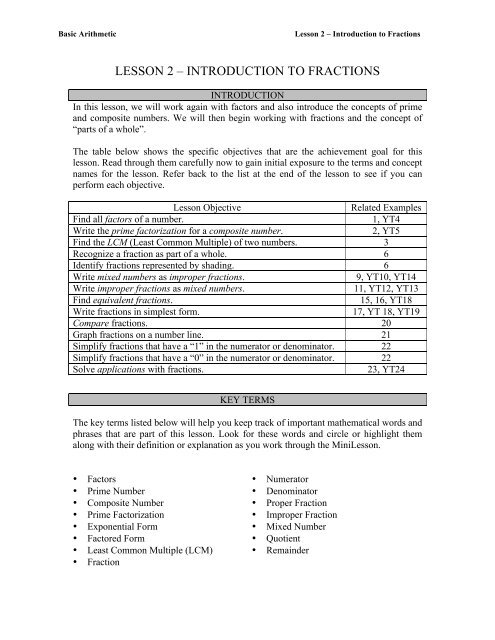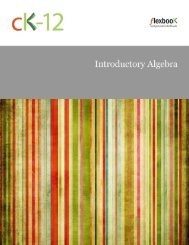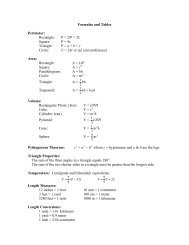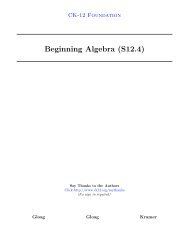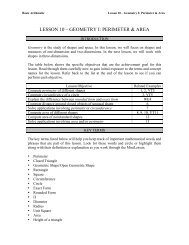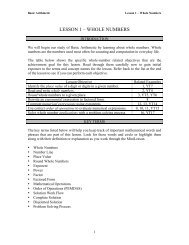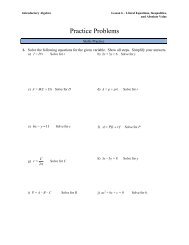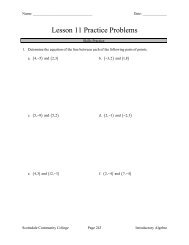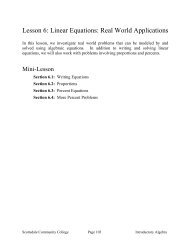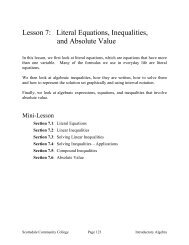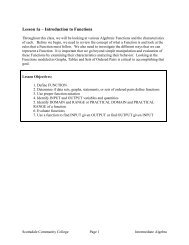LESSON 2 – INTRODUCTION TO FRACTIONS
LESSON 2 – INTRODUCTION TO FRACTIONS
LESSON 2 – INTRODUCTION TO FRACTIONS
You also want an ePaper? Increase the reach of your titles
YUMPU automatically turns print PDFs into web optimized ePapers that Google loves.
Basic ArithmeticLesson 2 <strong>–</strong> Introduction to Fractions<strong>LESSON</strong> 2 <strong>–</strong> <strong>INTRODUCTION</strong> <strong>TO</strong> <strong>FRACTIONS</strong><strong>INTRODUCTION</strong>In this lesson, we will work again with factors and also introduce the concepts of primeand composite numbers. We will then begin working with fractions and the concept of“parts of a whole”.The table below shows the specific objectives that are the achievement goal for thislesson. Read through them carefully now to gain initial exposure to the terms and conceptnames for the lesson. Refer back to the list at the end of the lesson to see if you canperform each objective.Lesson ObjectiveRelated ExamplesFind all factors of a number.1, YT4Write the prime factorization for a composite number.2, YT5Find the LCM (Least Common Multiple) of two numbers. 3Recognize a fraction as part of a whole. 6Identify fractions represented by shading. 6Write mixed numbers as improper fractions.9, YT10, YT14Write improper fractions as mixed numbers.11, YT12, YT13Find equivalent fractions.15, 16, YT18Write fractions in simplest form.17, YT 18, YT19Compare fractions. 20Graph fractions on a number line. 21Simplify fractions that have a “1” in the numerator or denominator. 22Simplify fractions that have a “0” in the numerator or denominator. 22Solve applications with fractions.23, YT24KEY TERMSThe key terms listed below will help you keep track of important mathematical words andphrases that are part of this lesson. Look for these words and circle or highlight themalong with their definition or explanation as you work through the MiniLesson.• Factors• Prime Number• Composite Number• Prime Factorization• Exponential Form• Factored Form• Least Common Multiple (LCM)• Fraction• Numerator• Denominator• Proper Fraction• Improper Fraction• Mixed Number• Quotient• Remainder
Basic ArithmeticLesson 2 <strong>–</strong> Introduction to Fractions<strong>LESSON</strong> CHECKLISTUse this page to track required components for your class and your progress on each one.ComponentRequired?Y or NComments Due ScoreMini-LessonOnlineHomeworkOnlineQuizOnlineTestPracticeProblemsLessonAssessment18
Basic ArithmeticLesson 2 <strong>–</strong> Introduction to FractionsMINI<strong>LESSON</strong>FAC<strong>TO</strong>RSThe factors of a number divide the number evenly (with remainder zero).Example 1: Find all factors of 24.PRIME FAC<strong>TO</strong>RIZATIONA prime number is a whole number that has only itself and 1 as factors.(Example: 2, 3, 5, 7, 13, 29, etc…)A composite number is a whole number that is not prime (i.e. has factors other than itselfand 1). Every composite number can be written as a product of prime factors. Thisproduct is called the prime factorization.Example 2: Find the prime factorization of each of the following. Write the final result inexponential form and factored form.72 600LEAST COMMON MULTIPLE (LCM)Example 3: The LCM of two numbers is the smallest number for which both numbersare factors. For example, the LCM of 2 and 4 is 4. The LCM of 3 and 5 is 15. Find theLCM of 8 and 10:Multiples of 8 are: ____________________________________________________Multiples of 10 are: ____________________________________________________Some common multiples of 8 and 10 are: ______________________________________The LEAST COMMON MULTIPLE of 8 and 10 is _________________19
Basic ArithmeticLesson 2 <strong>–</strong> Introduction to FractionsYOU TRY4. List the factors of 18. 5. Find the prime factorization of 270.<strong>FRACTIONS</strong>Suppose I buy a candy bar to split with two of my friends. What number could we use todiscuss how much of the bar each of us would get? Well, if we have 1 bar and it is splitinto 3 equal pieces, then we would say that each person gets 1 3 of the bar. The number 1 3is called a fraction because we use it to represent part (one part) of a whole (3 pieces).The fraction 1 3can be represented by the shaded part in each of the following diagrams.Notice that in each diagram, the whole is a different shape or set of shapes but the use ofthe fraction 1 3still applies.Example 6: Identify the fraction represented by the shaded part of each figure.YOU TRY7. Draw two different figures or sets of figures that are 3 4 shaded.20
Basic ArithmeticLesson 2 <strong>–</strong> Introduction to FractionsVocabulary of fractions:• The top number in a fraction is called the numerator.• The bottom number in a fraction is called the denominator.• Fractions for which the top number is smaller than the bottom are called properfractions.• Fractions whose numerator is larger than the denominator are called improperfractions and can be written as what are called mixed numbers.Example 8: Identify the fraction represented by the shaded part of each figure.Example 9: Express as an improper fraction.2 1 4112 3YOU TRY10. Write the steps to convert a mixed number to an improper fraction (from video above)Example 11: Express as a mixed number.a.425b. 539c. 847!21
Basic ArithmeticLesson 2 <strong>–</strong> Introduction to FractionsYOU TRY12. Write the steps to convert an improper fraction to a mixed number (from video above)13. Express 5711 as a mixed number. 14. Express 18 5as an improper fraction.EQUIVALENT <strong>FRACTIONS</strong>Each rectangle below has the same amount of shaded area. The simplest way to representthe shaded areas as a fraction is as 1 4 . All of the listed fractions are equivalent to 1 4 .1428312Example 15: Which of the given fractions are equivalent to414618!103527 ?1428Example 16: Find four fractions equivalent to 1 5 .22
Basic ArithmeticLesson 2 <strong>–</strong> Introduction to Fractions<strong>FRACTIONS</strong> IN SIMPLEST FORMFractions are in simplest form if they are completely reduced. To completely reduce afraction, remove all common factors other than 1 from the numerator and denominator.Leave fraction answers always in simplest form.Example 17: Write the following fractions in simplest form.416285436049518. Find two fractions equivalent to 3 8YOU TRY. 19. Write4072in simplest form.COMPARING <strong>FRACTIONS</strong>To compare fractions, create equivalent fractions with the same denominator thencompare the numerators.Example 20: Which is larger, 4 5 or 6 7 ?23
Basic ArithmeticLesson 2 <strong>–</strong> Introduction to FractionsAPPLICATION OF <strong>FRACTIONS</strong>Example 23: There are 14 men and 12 women in Professor Bohart’s MAT082 class.What fraction of the students in the class are women?GIVEN:GOAL:MATH WORK:CHECK:FINAL RESULT AS A COMPLETE SENTENCE:YOU TRY24. The local PTA group approved a fall carnival by a vote of 15 to 5. What fraction ofthe PTA group voted against the bill? Remember to reduce the final result.GIVEN:GOAL:MATH WORK:CHECK:FINAL RESULT AS A COMPLETE SENTENCE:25


